Jordan travel - Arab, Asia
Jordan officially known as the Hashemite Kingdom of Jordan, is located in the Southern Levant region of West Asia. As a small but significant nation in the Middle East, bordered by Syria, Iraq, Saudi Arabia, Israel, and the Palestinian territories. While not the largest country in the region, Jordan plays a crucial role as a haven of stability and a bridge between cultures. The country has a small coastline along the Red Sea in the southwest, separated from Egypt by the Gulf of Aqaba. Covering an area of approximately 89,342 square kilometers (34,495 square miles), Jordan is characterized by its semi-arid climate. Jordan offers a captivating blend of ancient history and modern development, creating an atmosphere that is both timeless and progressive.
Population: Estimate 11,500,000 people (as of 2024)
Economy: Jordan, with a GDP of $50.85 billion in 2023, boasts a well-diversified economy, where services and tourism play a major role, contributing 71% to the country’s GDP. With a well-developed hospitality industry and excellent customer service. The stable Jordanian dinar, pegged to the US dollar, makes it easier for visitors to manage expenses. Though Jordan's cost of living is relatively high compared to neighboring countries, urban areas like Amman offer great shopping and modern banking facilities.
Landmarks: Petra, Jerash, Wadi Rum, Dead Sea, Qasr Amra, Ajlun Castle, Kerak Castle, Mount Nebo ,Al-Maghtas
Jordan
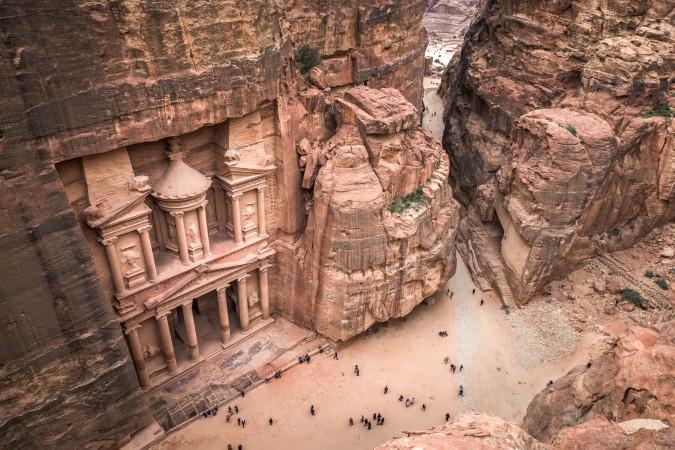
Overview of Jordan
History & Cultural Influence
Jordan's territory has been inhabited since prehistoric times, with evidence of settlements dating back to 7000 BC. The land has been home to various ancient civilizations, including the Nabataeans, Romans, and Byzantines, each leaving their mark on the country's cultural landscape.
Islamic Era
The arrival of Islam in the 7th century CE had a profound impact on the region. Jordan became an important part of various Islamic empires, including the Umayyad and Abbasid caliphates, which further enriched its cultural heritage.
Modern Era
In the 20th century, Jordan emerged as an independent state following World War I and the dissolution of the Ottoman Empire. The Hashemite Kingdom of Jordan was established in 1946, with the country playing a significant role in regional politics and conflicts.
While Islam is the predominant religion, Jordan is also home to one of the oldest Christian communities in the world. This religious diversity has contributed to a culture of tolerance and coexistence.
Interaction with The Locals
When visiting Jordan, you can expect a warm and hospitable welcome, deeply rooted in the country's Bedouin traditions and Islamic values. With a population mostly Arab, Jordanians are known for their genuine kindness and respect towards tourists. Visitors are treated with curiosity and openness, but it's important to be aware of local customs and etiquette to ensure positive and respectful interactions throughout your stay.
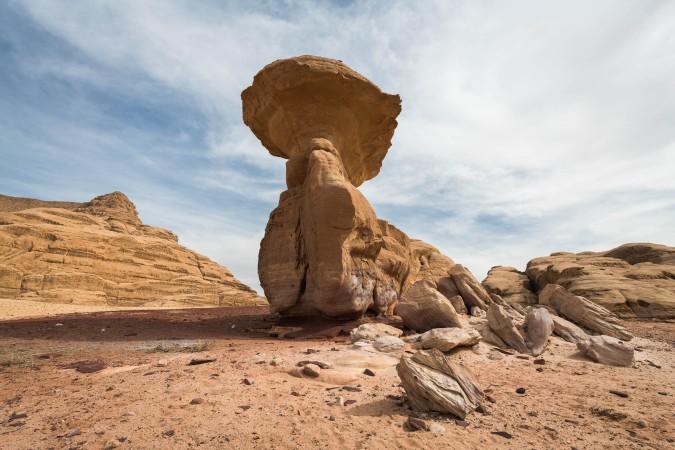
Jordan landscape - © Loschinina Olga
Top attractions in Jordan
Jordan offers a wealth of unforgettable experiences, from exploring the ancient city of Petra, a UNESCO World Heritage site carved into rose-colored cliffs, to floating effortlessly in the mineral-rich waters of the Dead Sea, the lowest point on Earth. Adventure seekers can immerse themselves in the dramatic desert landscapes of Wadi Rum, where visitors can trek, ride camels, and stay in traditional Bedouin camps under a star-filled sky.
Petra
Location: Southern Jordan, near Wadi Musa
Petra is an ancient Nabataean city carved into stunning rose-colored rock faces. Its most famous site is the Treasury (Al-Khazneh), but you’ll also find numerous tombs, a Roman-style theater, and Byzantine churches. As a UNESCO World Heritage site and one of the New Seven Wonders of the World, Petra is Jordan’s most visited and awe-inspiring destination.
Wadi Rum
Location: Southern Jordan, 60 km east of Aqaba
Known as the "Valley of the Moon," Wadi Rum offers a mesmerizing desert landscape of towering sandstone mountains and red dunes. Visitors can explore the vast terrain by jeep, camel, or on foot, and even enjoy a night under the stars in a traditional Bedouin camp. Its connection to T.E. Lawrence and as a famous movie set only adds to its allure.
Dead Sea
Location: Western Jordan, bordering Israel
The Dead Sea, the lowest point on Earth at 423 meters below sea level, is famous for its extremely salty waters where visitors can float effortlessly. The mineral-rich mud is also renowned for its therapeutic properties, making this a must-visit for a one-of-a-kind experience.
Jerash
Location: Northern Jordan, 48 km north of Amman
Jerash is one of the best-preserved Roman provincial cities in the world, offering a fascinating glimpse into ancient Roman life. Its well-preserved colonnaded streets, theaters, temples, and public squares transport visitors back in time to a city of grandeur and history.
Amman Citadel
Location: Central Amman
Situated atop the highest hill in Amman, the Citadel is a historical treasure trove with ruins from Roman, Byzantine, and Umayyad periods. Explore landmarks like the Temple of Hercules and the Umayyad Palace, while enjoying sweeping views of the modern city below.
Dana Biosphere Reserve
Location: South-central Jordan
Jordan’s largest nature reserve, Dana Biosphere Reserve, is a paradise for nature lovers. It offers incredible biodiversity across four distinct zones, stunning landscapes, and excellent hiking opportunities. The traditional stone village of Dana adds a cultural touch to the natural beauty of the reserve.
Aqaba
Location: Southern Jordan, on the Red Sea coast
Aqaba is Jordan’s only coastal city, renowned for its beautiful beaches and world-class diving in the Red Sea. The city is perfect for water sports enthusiasts, while its historical sites, including Aqaba Fort and the ruins of the early Islamic city of Ayla, provide a rich cultural backdrop.

Petra an ancient Nabataean city - © gather
Must-Try Dishes in Jordan
When visiting Jordan, be sure to try Mansaf, the national dish made of tender lamb cooked in a rich yogurt sauce, served over rice and symbolizing the country's deep sense of hospitality. For a unique experience, enjoy Maqluba, a flavorful one-pot dish of rice, meat, and vegetables, flipped upside down before serving. Don’t miss the sweet treat Knafeh, a syrup-soaked pastry with cheese, often topped with pistachios, perfect for satisfying your dessert cravings.
Mansaf
Mansaf is Jordan’s national dish and a true symbol of hospitality and generosity. Tender lamb is slow-cooked in a flavorful sauce made from jameed (fermented dried yogurt) and served over a bed of rice, often accompanied by thin flatbread called shrak. Mansaf is traditionally enjoyed during special occasions like weddings, holidays, and family gatherings, highlighting the importance of communal dining and cultural pride.
Maqluba
Maqluba, meaning "upside down" in Arabic, is a delightful one-pot meal where layers of rice, meat (usually chicken or lamb), and vegetables are cooked together, then flipped upside down onto a serving platter for a dramatic reveal. Popular for family gatherings and celebrations, this dish showcases Jordanian creativity and culinary flair.
Knafeh
Knafeh is a beloved Jordanian dessert made from syrup-soaked pastry and layered with cheese or semolina, often topped with crushed pistachios. Served warm, this sweet treat is a must at celebrations and gatherings, symbolizing joy and festivity while delighting both locals and visitors with its rich flavors.
Fattoush
Fattoush is a refreshing salad featuring mixed greens, tomatoes, cucumbers, radishes, and crispy pieces of fried or toasted bread, all tossed in a zesty lemon and sumac dressing. This light and tangy dish highlights the importance of fresh vegetables in Jordanian cuisine and is a perfect side for any meal, promoting healthy, wholesome eating.
Tabbouleh
Tabbouleh is a vibrant salad made with finely chopped parsley, tomatoes, mint, onions, and soaked bulgur, all dressed in olive oil and lemon juice. As a staple in Jordanian cuisine, tabbouleh reflects the region's agricultural richness, with its emphasis on fresh herbs and ingredients that celebrate the country’s connection to the land.
Shish Barak
Shish Barak features delicate dumplings filled with spiced meat, typically lamb or beef, cooked in a tangy yogurt sauce. This comforting dish is often served at special occasions and family gatherings, reflecting Jordan’s love for rich, hearty meals that bring families together around the table.
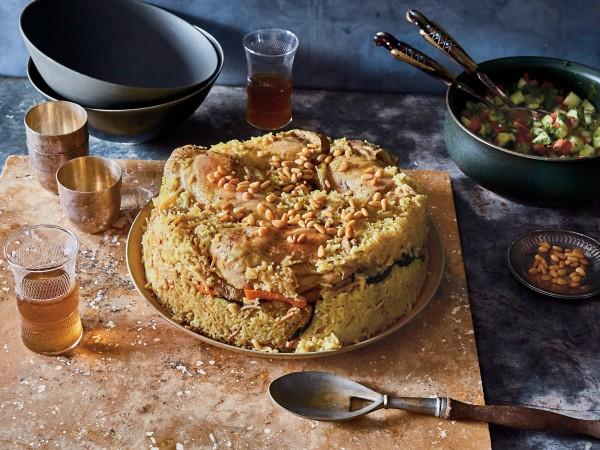
Maqluba - © Gentl and Hyers
Festivals & Local Celebrations
Jerash Festival of Culture and Arts
Time: July-August annually
Set against the backdrop of the ancient Roman city of Jerash, this festival is one of Jordan's premier cultural events. Visitors can immerse themselves in live performances from local and international artists, including music, dance, and theater. The festival also features art exhibitions, traditional handicraft displays, delicious Jordanian food stalls, and spectacular evening shows in the iconic Roman amphitheater.
Eid al-Fitr
Time: Varies annually (marks the end of Ramadan)
Eid al-Fitr is one of the most significant Islamic holidays, celebrated joyfully across Jordan. Visitors can soak up the festive atmosphere in cities and towns, witness special prayers at mosques, and enjoy the warmth of family gatherings and feasts. Traditional sweets and public celebrations, with fireworks in some areas, add to the excitement of this special time.
Amman Design Week
Time: October (biennial event)
Amman Design Week highlights Jordan’s vibrant creative scene, offering exhibitions of innovative design work from local and regional artists. Attendees can explore workshops, talks by designers, and pop-up shops featuring Jordanian-made products. With architectural tours of Amman and interactive public art installations, this event is a must for design enthusiasts.
Aqaba Traditional Arts Festival
Time: February annually
Hosted in the coastal city of Aqaba, this festival celebrates Bedouin and local traditions. Visitors can enjoy live demonstrations of traditional crafts, Bedouin music and dance performances, and local food specialties. Cultural activities and workshops further immerse guests in the rich heritage of the region, making it a truly authentic experience.

Jerash Festival of Culture and Arts - © gather
Weather in Jordan: Best Time to Visit
Best Times to Visit Jordan
If you’re planning a trip to Jordan, the ideal seasons to experience its wonders are spring (March to May) and fall (September to November). During these months, the weather is simply delightful, with temperatures ranging from a comfortable 18°C (64°F) to 28°C (82°F)—perfect for exploring the rich history and breathtaking landscapes.
Temperature Insights
- Summer (June to August): Expect scorching heat, with temperatures soaring up to 40°C (104°F) in certain areas. If you can handle the heat, you’ll find fewer crowds!
- Winter (December to February): This season brings a chill, with temperatures occasionally dipping below 0°C (32°F) in some regions. In places like Amman and Petra, you might even encounter snowfall, adding a magical touch to the scenery.
- Spring and Fall: These are the sweet spots for travel, offering mild and pleasant conditions ideal for outdoor adventures.
Rainfall Patterns
Winter months, particularly January, are the rainiest, providing much-needed moisture to the landscape. Conversely, summer is characterized by dry, arid conditions with little to no rainfall, making it a perfect time for desert explorations if you can handle the heat.
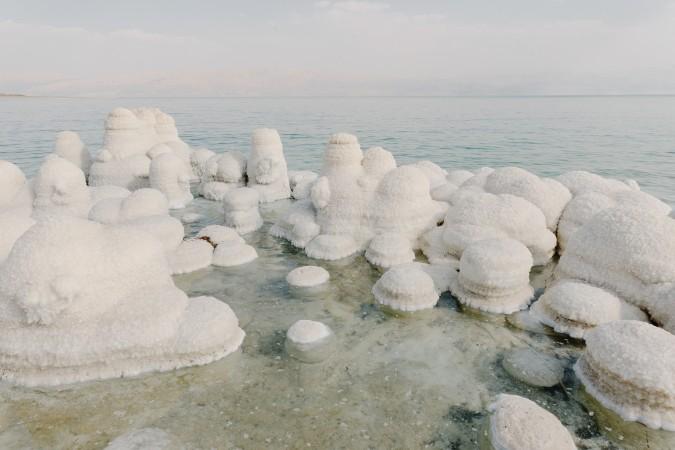
Dead Sea - © Ofir Berman
Culture Etiquette in Jordan
Greetings and Hospitality
Greetings in Jordan are important and often involve handshakes, particularly between men. If greeting a woman, it's best to wait for her to offer her hand first. The common Arabic greeting is "As-salamu alaykum" (Peace be upon you), with the response "Wa alaykum as-salam." Jordanians are known for their hospitality, and it’s common to be offered tea or coffee when visiting someone’s home or shop—accepting this gesture is a sign of respect.
Dress Modestly
Jordan is a conservative country, so modest clothing is appreciated. For women, this means covering shoulders and knees, particularly in more rural or religious areas. Men should also avoid wearing shorts in public spaces, though they’re acceptable at tourist sites like the Dead Sea or Aqaba.
Respect for Religion
Islam plays a central role in Jordanian life, and visitors should be respectful of religious practices. If visiting a mosque, dress conservatively, remove your shoes, and women should cover their hair. During the holy month of Ramadan, refrain from eating, drinking, or smoking in public during daylight hours out of respect for those fasting.
Public Displays of Affection
Public displays of affection, such as kissing or hugging, are generally frowned upon in Jordan, especially in more traditional areas. It's best to reserve such gestures for private settings.
Use of the Right Hand
In Jordanian culture, the right hand is used for eating, greeting, and giving or receiving items, as the left hand is considered unclean. When dining, especially if eating with your hands, always use your right hand.
Tipping and Bargaining
Tipping is common in Jordan and is appreciated for services such as dining and taxi rides. In markets, bargaining is expected, especially in souks, but always do so with a smile and respect for the vendor.
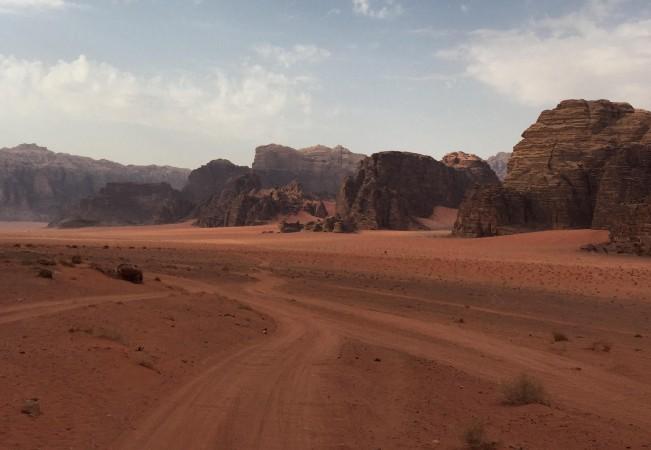
Wadi Rum desert - © gather
Essential Travel Information
Transportation
Airport Transfers
Jordan offers convenient private transfer options from its main airports to key destinations:
- Queen Alia International Airport (Amman): Airport taxis provide safe and reasonably-priced transportation to anywhere in Jordan. You can also book private transfers to places like Amman city center, the Dead Sea, Petra, or Wadi Rum.
- Aqaba Airport: Private transfers are available to Aqaba city center, Petra, Wadi Rum, and the Dead Sea, making it easy to get where you need to go.
Public Transit
Public transportation in Jordan is somewhat limited:
- Buses connect major cities, but they can be infrequent and crowded, making them less ideal for tourists.
- Within Amman, public buses are available, though the routes can be confusing for visitors. Many travelers opt for taxis or private transfers instead of navigating the local transit system.
Taxis
Taxis are widely accessible in Jordan’s major cities:
- In Amman, yellow taxis are metered and generally affordable.
- At Queen Alia International Airport, taxi fares are regulated with fixed prices displayed near the taxi area, ensuring a hassle-free experience.
Ride-Sharing Services
Uber and Careem are available in Amman and other major cities, offering a convenient alternative to taxis. These services can be especially useful for travelers who are unfamiliar with local routes or prefer a cashless transaction.
Private Transfers
For those looking for more comfort and flexibility, private transfer services are widely available. You can choose from sedans, minivans, or even luxury vehicles to travel between popular destinations like Amman, Petra, Wadi Rum, the Dead Sea, and Aqaba. This option is perfect for groups, families, or anyone with luggage who prefers a hassle-free journey.
ATM and Banking Services
Jordan has a well-developed network of ATMs and banking services, making it easy for travelers to access their accounts while exploring the country.
- Bank of Jordan offers 192 ATMs across the country, providing 24/7 access to your funds.
- Housing Bank for Trade and Finance (HBTF) also has a wide network of ATMs that operate around the clock, including on public holidays.
Common ATM services include cash withdrawals (with some ATMs offering USD), cash deposits, account transfers, credit card payments, and even PIN code changes. Jordanian banks also offer some unique services, such as mobile ATM buses that bring banking directly to various locations, Interactive Teller Machines (ITMs), and services tailored to special needs clients at select branches and ATMs.
Accommodation Choices in Jordan
Jordan offers a wide range of accommodation options to suit every traveler's budget and preferences:
- Hotels: From luxury international chains to charming boutique hotels, you’ll find plenty of options in major cities like Amman and popular tourist destinations like Petra and the Dead Sea.
- Resorts: These are particularly common around the Dead Sea and Aqaba, offering all-inclusive packages and breathtaking views.
- Guesthouses: For a more authentic experience, guesthouses in smaller towns and rural areas allow visitors to connect with local culture.
- Desert Camps: In Wadi Rum, you can stay in traditional Bedouin-style tents or opt for a more luxurious “glamping” experience under the stars.
- Hostels: Budget travelers and backpackers will find hostels in major cities and tourist hubs, offering affordable stays and the chance to meet fellow adventurers.
Articles for you

Explore Yala National Park - Sri Lanka Travel, Asia
Tucked away in Sri Lanka’s southeastern corner, Yala National Park is where wild nature meets deep tradition. Known worldwide for its leopard population, the park is also home to elephants, sloth bears, crocodiles, and hundreds of bird species. Beyond wildlife, Yala opens doors to a cultural landscape dotted with ancient temples, Buddhist ruins, and coastal villages. For travelers seeking more than just a safari, Yala offers a chance to explore eco-tourism, local communities, and sacred heritage sites.
Population: The Yala National Park area doesn’t have a human population.
Economy: The economy around Yala National Park thrives on a blend of eco-tourism, agriculture, and local services. Safari tours, eco-lodges, and cultural experiences drive steady income for nearby towns like Tissamaharama and Kataragama, supporting thousands of families.
Landmarks: Famous for Block I of Yala and wildlife encounters, including elephants, sloth bears, crocodiles, and exotic bird species.

Explore Galle - Sri Lanka Travel, Asia
Nestled on Sri Lanka’s southern coastline, Galle is a vibrant city where history meets the sea. Its cobbled streets, colonial architecture, and serene beaches make it a must-visit destination for travelers seeking a blend of culture, adventure, and relaxation. A UNESCO World Heritage site, Galle captivates visitors with its Dutch Fort, bustling markets, and friendly locals. Whether you’re exploring the ramparts at sunset or savoring fresh seafood by the shore, Galle promises an unforgettable journey into Sri Lanka’s heritage.
Population: Approximately 113,000 in 2023.
Economy: Galle’s economy thrives on tourism, trade, and fisheries. The city’s historic fort, colonial architecture, and coastal charm draw thousands of international visitors each year, making tourism its main economic driver. Fishing remains vital for local livelihoods, supplying fresh seafood across the region.
Landmarks: Famous for the Galle Fort, Dutch Reformed Church & Maritime Museum, and Unawatuna Beach.

Explore Bentota - Sri Lanka Travel, Asia
Nestled along Sri Lanka’s southwestern coast, Bentota is a tropical paradise that blends golden beaches, vibrant culture, and thrilling adventures. Famous for its calm waters, luxury resorts, and scenic river estuary, Bentota has become a top destination for travelers seeking both relaxation and authentic experiences. From serene beach walks at sunrise to adrenaline-pumping water sports, this coastal town offers a perfect balance of leisure and exploration. With its proximity to Colombo and Galle, Bentota is easy to reach, making it an ideal stop for both short escapes and extended holidays.
Population: Approximately 37,000 in 2023.
Economy: Bentota’s economy thrives mainly on tourism, which drives local businesses such as hotels, restaurants, and wellness retreats. The town also benefits from fishing, coconut cultivation, and handicrafts like wood carving and batik textiles. Many residents rely on the growing demand for water sports and Ayurvedic treatments, making tourism the backbone of both income and employment in the area.
Landmarks: Famous for Bentota Beach, Bentota River Safari, and Kande Vihara Temple.

Explore Mirissa - Sri Lanka Travel, Asia
Mirissa is a charming coastal town on Sri Lanka’s southern shoreline. Known for its golden beaches, turquoise waters, and vibrant marine life, it has become a must-visit stop for travelers exploring the island. Many come for whale watching, surfing, and sunset views at Coconut Tree Hill, but Mirissa offers much more than postcard beauty. The fishing boats you see anchored by the bay carry generations of stories. Local traditions, delicious cuisine, and a laid-back rhythm of life shape every visitor’s experience.
Population: Approximately 4,700 in 2023.
Economy: Mirissa’s economy is largely shaped by its coastal location. Fishing has long been the backbone of local livelihoods, with generations relying on the Indian Ocean for income. In recent decades, tourism has become the main driver of growth, thanks to whale watching, surfing, and beachside hospitality.
Landmarks: Famous for Mirissa Beach, Coconut Tree Hill, and Parrot Rock Bridge.

Explore Nuwara Eliya - Sri Lanka Travel, Asia
Tucked away in the Central Highlands of Sri Lanka, Nuwara Eliya is often called “Little England”. With its rolling tea plantations, cool misty mornings, and colonial charm, this mountain town feels like a step into another world. Travelers come here to breathe fresh air, walk through flower gardens, sip the finest Ceylon Tea, and enjoy a pace of life far from the island’s busy cities. Whether you’re drawn by scenic landscapes, heritage architecture, or the warmth of its people, Nuwara Eliya is a destination that blends nature, culture, and history in perfect harmony.
Population: Approximately 781,000 in 2023.
Economy: Nuwara Eliya’s economy thrives mainly on tea production, as it sits in the heart of Sri Lanka’s central highlands, famous worldwide for Ceylon Tea. The city also benefits from a growing tourism industry, attracting visitors with its colonial charm, cool climate, and scenic landscapes.
Landmarks: Famous for Gregory Lake, Hakgala Botanical Garden, and Victoria Park.

Explore Sukau - Malaysia Travel, Asia
Nestled on the banks of the Kinabatangan River in Sabah, Malaysian Borneo, Sukau is a destination where wildlife, culture, and conservation come together. Known as one of Asia’s top spots for river safaris and eco-tourism, this quiet village offers a front-row seat to encounters with Bornean orangutans, pygmy elephants, proboscis monkeys, and exotic birdlife.
Population: Approximately 1,400 in 2019.
Economy: Sukau’s economy is shaped by its riverine location and natural resources. Traditionally, the Orang Sungai community relied on fishing, small-scale farming, and forest gathering for their livelihood. Today, the village has shifted toward eco-tourism, with river cruises, jungle trekking, and homestays providing income.
Landmarks: Famous for the Kinabatangan River cruises, Gomantong Caves, and Ox-bow lakes and wetlands.
